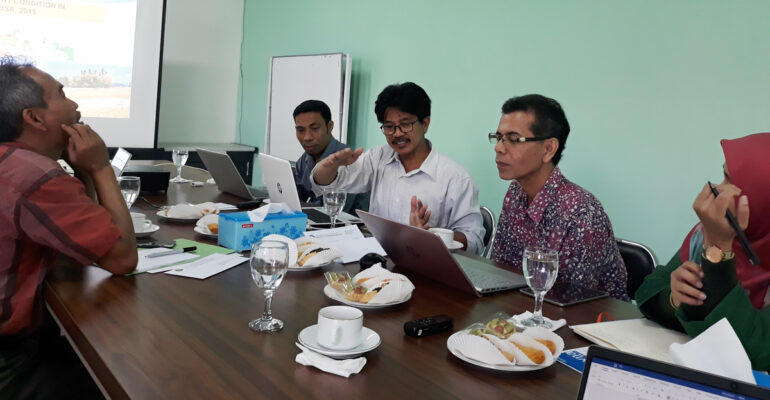IPB Experts Respond to Drought Problems That Affect the Agriculture Sector

An Interdisciplinary Expert Discussion (DPI) held by the Directorate of Scientific Publication and Strategic Information of IPB discussed the solution to overcome the drought that still takes effects, especially in the agricultural sector. Although Indonesia has humid tropic characteristics, the problem of drought always recurs every year, so it needs national attention. More systematic and planned coping and anticipation efforts need to be designed so that this problem does not recur in the future.
Paddy rice farmers are the parties who really feel the effects of this drought both in terms of quantity and quality of production. The quantity will be reduced in quantity, and the production decline will occur more drastically when drought occurs at the beginning of planting because it can result in crop failure. Whereas in terms of quality, drought can cause weight per thousand grains to be lower and rice grains to increase.
This DPI presented several experts namely Prof. Dr. Muhamad Syukur, Dr. Soeryo Wiyono, Dr. Suria Darma Tarigan, and Dr. Ahmad Junaidi, led by the Director of IPB’s Scientific and Strategic Information Publications, Dr. Eva Anggraini. In the meeting of the experts, a number of strategic and measurable strategic formulations that can be implemented in the short, medium and long term have been produced.
Short-term steps that must be done include, from the aspect of technical culture that is using the selection of rice varieties that are adaptive to drought, including INPAGO for the Gadu planting season (the second planting season in March-April) and several INPARI varieties namely early maturing or short-lived varieties. In addition, it is necessary to maintain soil organic matter with organic fertilizer or by returning straw to paddy fields. Use of microbial inducing drought tolerance such as Plant Growth Promoting Rhizobacteria (PGPR) microbes and increasing water holding capacity or the use of Endophytic Fungal microbes to stimulate root growth so that transpiration can be suppressed.
Planning in the transition season is a step that needs to be done in the medium term, among others, by building reservoirs to regulate and accommodate the supply of rainwater flow and to improve water quality. But in the long run, the management of watershed management (DAS) is a must to increase the absorption of rainwater into the ground. Springs conservation through various water conservation techniques (for example infiltration wells) as well as improvement of watershed forest cover upstream are steps that need to be taken.
In addition, it is necessary to enable tools for educating farmers through strengthening information systems to support farmers’ decisions in conducting production activities. Collaboration between the government, universities and related stakeholders needs to be increased to further socialize and be actively involved in optimizing several programs that have existed or are currently still being run by the government, such as the Climate Field School, KATAM (Calendar of Planting) socialization and Map Growth Index (BMKG). These various programs need to be continuously enriched and continuously updated programs and materials by involving universities, and their use needs to be integrated with information technology so that it can be applied easily by farmers.
Related to the need to anticipate the impact of the El Nino event in 2019, especially when entering the dry season, it was previously discussed and socialized by climate and agriculture experts in February through the workshop “Prospects for El Nino 2019 Development: Its Impact on Climate and Agricultural Anomalies in Indonesia “Organized by IPB in collaboration with PT. East West Indonesia. One of the recommendations made is the importance of precise climate information to assist in determining the planning of farming that is vulnerable to being affected by various impacts of climate anomalies. The benefits of climate prediction information for agriculture are enormous including: 1) regulating cropping patterns according to water availability; 2) selecting commodities and varieties according to climate predictions; 3) adaptation efforts are more focused and precise location, such as for areas that are predicted to dry can provide water through pump wells, ditches, reservoirs, longstorage, while for those predicted to be wetter can prepare a good drainage system; 4) reduce yield losses due to drought or pest attacks.
On a separate occasion, Head of the Strategic Information Head of DPIS who is also a climate expert, Dr. Akhmad Faqih, said that in July 2019 this indicator of ENSO events from sea surface temperature data in the eastern and central Tropical Pacific Ocean showed conditions towards ENSO-neutral but still in conditions above the average value. However, the warning about El Nino is still given as delivered by climate prediction centers such as the International Research Institute for Climate and Society (IRI) with the consideration that now is still a transition period from El Nino to neutral or normal. On the other hand, despite declaring that conditions are now neutral, other institutions such as the Australian Bureau of Meteorology (BoM) warn of predictions of the possibility of a positive Indian Ocean Dipole (IOD) (positive IOD) for the next few months. Similar to El Nino, usually a positive IOD condition will also cause some regions in Indonesia, especially in the west such as parts of Sumatra, Java and Kalimantan to experience drought with less rainfall than normal conditions. (RYS)


